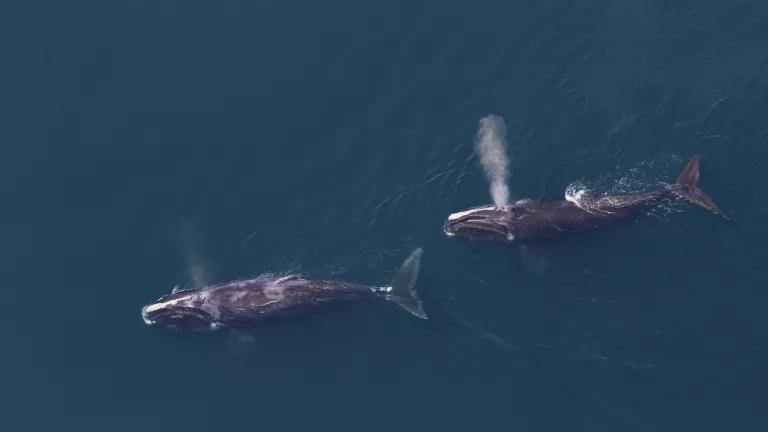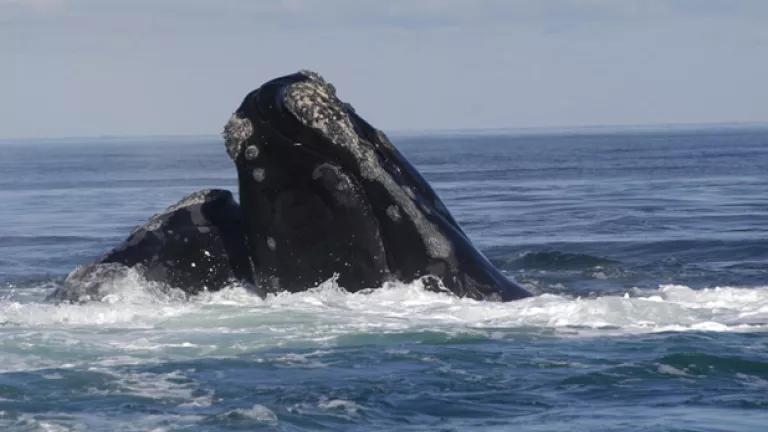Smart Siting of Offshore Wind Protects Right Whales in Gulf of Maine
The Biden administration is advancing offshore wind in areas of the Gulf of Maine that pose a lower risk to endangered North Atlantic right whales.

Protections for endangered North Atlantic right whales are an essential component of responsible offshore wind development.
Tim Cole/NOAA Fisheries, NEFSC
The Final Wind Energy Area (WEA) identified for potential offshore wind development in the Gulf of Maine is largely located away from habitats of higher importance to endangered North Atlantic right whales. This smart siting decision will help the industry advance responsibly in this new offshore wind region.
We need offshore wind, and we need to do it right. This kind of clean energy will help eliminate dangerous greenhouse gas emissions and create thousands of well-paying sustainable jobs. But as we fight climate change, we must avoid, minimize, and mitigate threats to ocean life in whatever ways we can.
North Atlantic right whales are highly endangered, and their survival is at serious risk due to a combination of vessel strikes and entanglements in fishing gear. Humans cannot cause even one right whale death or injury each year if the species is to avoid extinction. The whales are also being stressed by underwater noise pollution and experiencing general malnourishment, ill health, and impaired reproduction, all while fighting to adapt to climate change.
With the species simply unable to withstand more loss or disturbance, the right whale crisis is not a problem caused by the offshore wind industry, but it is one the industry must face.
Offshore wind development should avoid and minimize harms to marine mammals and other species during development, including through mitigation measures that reduce the risk from vessel strikes, noise pollution, and habitat disturbance. Mitigation measures should also address the potential risk of entanglement from floating offshore wind turbines that are likely to be used in the Gulf of Maine due to its deeper waters.
One of the most effective ways to reduce the risk to right whales is to simply avoid developing offshore wind in habitat areas of importance to the species. This is tricky in the Gulf of Maine as the entire area is critical habitat for North Atlantic right whales designated under the Endangered Species Act. However, science shows that some areas of the Gulf are of higher importance to right whales than others and this information can help guide siting decisions. Still, strong, precautionary requirements to protect the species throughout all stages of offshore wind development will remain of utmost importance.
The Final WEA issued by the Bureau of Ocean Energy Management (BOEM), the federal agency mandated with permitting offshore wind energy in the United States, comprises one contiguous area of just over 2 million acres in size and a combined capacity of 32 gigawatts of offshore wind energy. Importantly for the right whale, the Final WEA avoids many of the areas that the latest science indicates are of outsized importance to right whales.

Map of the Final Gulf of Maine Wind Energy Area (WEA), shown in green. Several areas of particular importance for right whales were removed from consideration.
BOEM
For example, BOEM has eliminated from consideration three “restricted areas” where NOAA Fisheries prohibits or otherwise regulates fishing to protect right whales from entanglement, as required by the Atlantic Large Whale Take Reduction Plan. All three restricted areas represent habitat that has remained consistently important for right whales during their seasonal migration, including for activities such as feeding, socializing, and transiting.
BOEM also removed an area for which there is emerging evidence of a migratory corridor to the north of Georges Bank for right whales moving between the Gulf of Maine and Canadian waters. Nine underwater hydrophones designed to listen out for right whale vocalizations were deployed by NOAA Fisheries in May 2022. Right whale calls were detected by all nine hydrophones in both May and June that year, corresponding with the location of modelled areas of core abundance for right whales from May to July. Portions of the migratory corridor have also previously been identified as important foraging habitat for right whales, as well as species of marine birds.
BOEM’s removal of the restricted areas and the migratory corridor from the Final WEA indicates the kind of precautionary approach necessary to protecting the species while advancing offshore wind energy development. The agency’s decision is also in line with the North Atlantic Right Whale and Offshore Wind Strategy that BOEM and NOAA Fisheries jointly released earlier this year.
Right whales were not the only focus of BOEM’s siting decision. The Final WEA also excludes:
- An area extending from the coastline, including islands, to 24 nautical miles offshore to protect the myriad species of birds, including puffins and Arctic terns, that forage mainly in this area of the Gulf during the breeding season.
- Known areas of deep-sea coral habitat—vulnerable to the anchoring of vessels during offshore wind construction and of the floating platforms themselves.
- Cashes Ledge, an ecologically rich area and home to the deepest, densest cold-water kelp forest on the Eastern seaboard.
- Jordan’s Basin, an important physical and oceanographic feature in the Gulf of Maine that is also of critical importance in supporting the life cycle and aggregations of the North Atlantic right whale’s preferred prey, the zooplankton Calanus finmarchicus.

Floating offshore platforms anchored with mooring lines will be the technology of choice for the Gulf of Maine due to its deeper waters.
Besiki Kazaishvili/NREL
Not all areas of concern were taken off the table. An area in the central Gulf of Maine (identified by BOEM as “Secondary Area C”) that has been shown to be of key importance to North Atlantic right whales based on habitat models, long-term sightings data, behavioral information, the distribution and density of their primary prey, and is in close proximity to one of the NOAA Fisheries restricted areas, could still be the site of offshore wind development.
A large portion of Wilkinson’s Basin also remains under consideration. This basin not only represents the primary source of supply of Calanus finmarchicus to North Atlantic right whale feeding grounds in the waters off Southern New England, including the Great South Channel and Georges Bank, but signs point to it being a far more climate resilient habitat for the zooplankton species compared to Jordan Basin.
And siting is just the first step. As the agency moves forward with leasing, BOEM should include a set of environmental measures as lease stipulations to ensure that offshore wind development proceeds in a manner that safeguards vulnerable ocean habitats and wildlife. We urge BOEM to adopt conditions that require comprehensive mitigation and monitoring of impacts including vessel strikes, entanglements, noise pollution, and habitat displacement, as well as requirements for adaptive management.
Floating offshore wind technology is new globally, and the Gulf of Maine is an ecologically important region where many data gaps still exist. As such, comprehensive baseline and post-project monitoring and implementation of an adaptive management framework will be critical to enhancing our understanding of cumulative adverse impacts and using those lessons learned to keep adjusting course to make sure offshore wind is developed responsibly.




